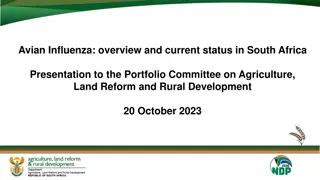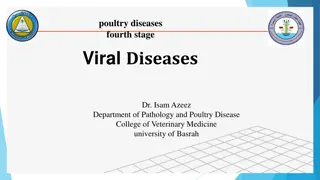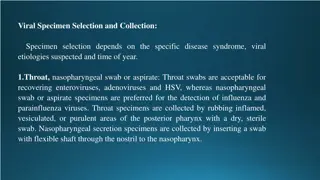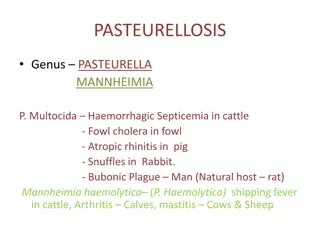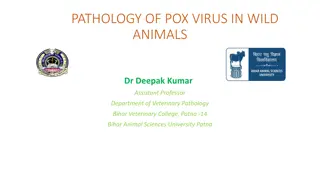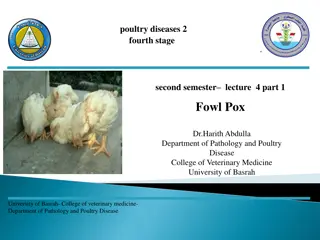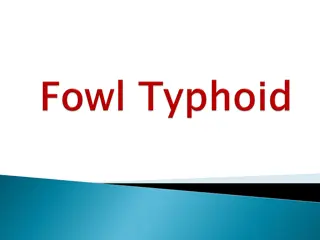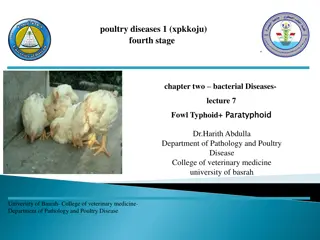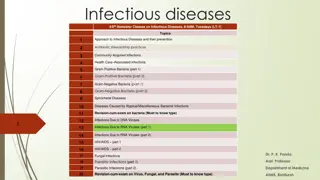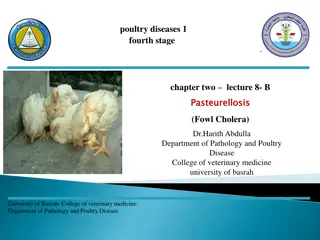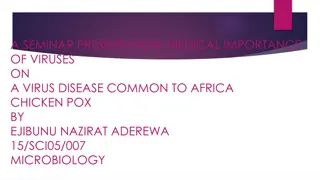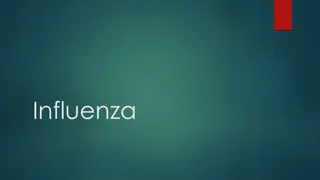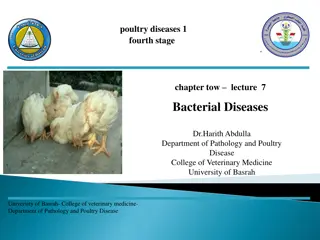Avian Viral Diseases: Fowl Pox & Ranikhet
Avian viral diseases like Fowl Pox and Ranikhet impact domestic fowl, causing nodular skin lesions, respiratory issues, and high mortality rates. Learn about their etiology, clinical signs, prevention, and control measures.
Download Presentation

Please find below an Image/Link to download the presentation.
The content on the website is provided AS IS for your information and personal use only. It may not be sold, licensed, or shared on other websites without obtaining consent from the author.If you encounter any issues during the download, it is possible that the publisher has removed the file from their server.
You are allowed to download the files provided on this website for personal or commercial use, subject to the condition that they are used lawfully. All files are the property of their respective owners.
The content on the website is provided AS IS for your information and personal use only. It may not be sold, licensed, or shared on other websites without obtaining consent from the author.
E N D
Presentation Transcript
What is a disease Any condition that results in deviation from normal function
How do diseases occur? AGENT HOST ENVIRONMENT
ETIOLOGY Infectious Agents Non-infectious agents Bacteria Viruses Parasites Fungi Chemical Physical Lack or excess of certain vitamins and minerals Toxins
General Signs of Disease Poor appetite Huddling Depression Runting/stunting poor uniformity Ruffled feathers Coughing, sneezing, oculo-nasal discharge, difficult breathing Bloody or wet litter Increased mortality
FOWL POX Viral disease of domestic fowl development of nodular proliferative Skin lesions on the featherless parts of the body. fibrino necrotic and proliferative lesions in the mucous membranes
ETIOLOGY Family: Pox viridae Genus: avipoxvirus Double stranded DNA
CLINICAL SIGNS Appearance of nodular lesions combs wattles eyelids other unfeathered areas of the body.
PREVENTION AND CONTROL Prophylactic vaccination Fowl pox vaccine at 4-6 weeks of age Second dose at 12-14 weeks of age.
RANIKHET DISEASE New castle disease Viral disease of domestic fowl is characterised by respiratory signs often associated with nervous and digestive disorders high mortality.
ETIOLOGY Paramyxoviridae Paromyxovirus-1
CLINICAL SIGNS opisthotonus Listlessness Increased respiration Weakness Edema around the eyes Torticolis Paralysis of legs
Prevention and control Prophylactic vaccination Lentogenic strain (F or B1) day old chicks intranasal intraocular route drinking water. Mesogenic strain (R2B) 6-8 weeks of age intramuscular Subcutaneous route.
INFECTIOUS CORYZA FOWL CORYZA Highly contagious acute disease of upper respiratory tract of chickens, turns into a chronic respiratory disease.
ETIOLOGY Haemophilus paragallinarum Small cocoid or gram negative rod Non motile Exhibits bipolar staining
CLINICAL SIGNS Serous to mucoid nasal discharges with foul smelling Facial edema Conjunctivitis Swollen wattles Diarrhoea Reduced feed and water consumption.
Treatment and control Gentamicin Penicillin streptomycin delivered in feed or drinking water. Proper Disinfection
BACILLARY WHITE DIARRHOEA PULLORUM DISEASE Fatal septicemia of young chicks . Salmonella.pullorum
CLINICAL SIGNS Somnolecence Weakness Loss of appetite Chalky white diarrhoea Stained greenish brown(sometimes) in and around vent
TREATMENT Enrofloxacin Parenteral injections Oral liquids Supportive therapy
BUMBLE FOOT PODODERMATITIS Injury to the lower surface of the foot and subsequent infection with Staphylococcus bacteria
Common causes of injury: Rough perches Splinters Wire floors Poor litter or bedding quality
CLINICAL SIGNS Lameness Swelling of the foot pad Hard, pus filled abscess on foot pad
TREATMENT Soak foot in warm water and Epsom salts. disinfect with alcohol. If skin is open, drain pus from abscess. Flush abscess cavity with hydrogen peroxide to cleanout pus and debris. Pack the cavity with antibiotic ointment . wrap the footwith gauze and elastic bandage. Repeat daily until foot heals.
PREVENTION AND CONTROL Provide good quality litter or bedding. Keep bedding clean, dry, and deep. Keep perches less than 18 inches from the floor to prevent foot damage due to impact from jumping. Remove potential sources of injury such as sharp objects and/or surfaces.
CURLED TOE PARALYSIS Defeciency of Riboflavin Poor growth Weakness Emaciation and diarrhoea unable to walk as their toes are turned inwards Drooping of wings
TREATMENT Riboflavin @3.6 mg/kg of feed in chicks Riboflavin @ 1.8 mg/kg of feed in growers Riboflavin @ 2.2mg/kg of feed in layers



